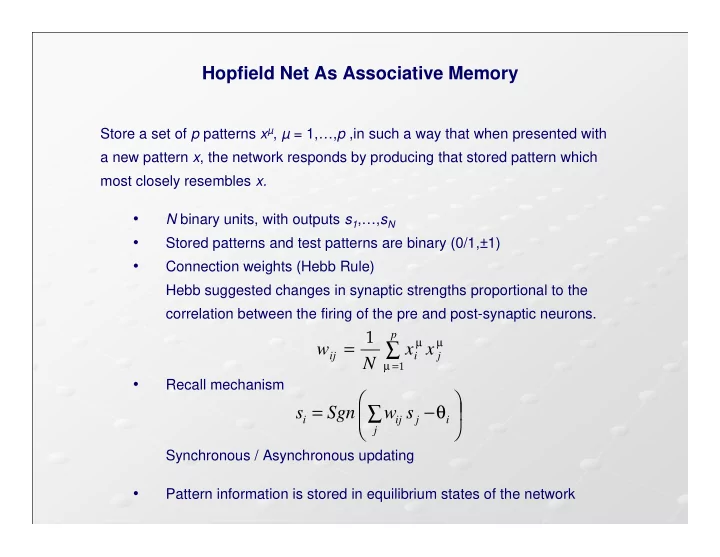

Hopfield Net As Associative Memory Store a set of p patterns x µ , µ = 1,…, p ,in such a way that when presented with a new pattern x , the network responds by producing that stored pattern which most closely resembles x. • N binary units, with outputs s 1 ,…, s N • Stored patterns and test patterns are binary (0/1,±1) • Connection weights (Hebb Rule) Hebb suggested changes in synaptic strengths proportional to the correlation between the firing of the pre and post-synaptic neurons. p 1 µ µ = ∑ w x x ij i j N µ = 1 • Recall mechanism = ∑ − θ s Sgn w s i ij j i j Synchronous / Asynchronous updating • Pattern information is stored in equilibrium states of the network
Example With Two Patterns • Two patterns X 1 = (-1,-1,-1,+1) X 2 = (+1,+1,+1,+1) • Compute weights 1 2 µ µ = ∑ w x x ij i j 4 µ = 1 • Weight matrix 2 2 2 0 2 2 2 0 1 = w 2 2 2 0 4 0 0 0 2 • Recall = ∑ s Sgn w s i ij j j Input (-1,-1,-1,+1) → • (-1,-1,-1,+1) stable Input (-1,+1,+1,+1) → • (+1,+1,+1,+1) stable Input (-1,-1,-1,-1) → • (-1,-1,-1,-1) spurious
Associative Memory Examples An example of the behavior of a Hopfield net when used as a constant-addressable memory. A 120 node net was trained using the eight examplars shown in (A). The pattern for the digit “3” was corrupted by randomly reversing each bit with a proba- bility of 0.25 and then applied to the net at time zero. Outputs at time zero and after the first seven iterations are shown in (B).
Associative Memory Examples Example of how an associative memory can reconstruct images. These are binary images with 130 x 180 pixels. The images on the right were recalled by the memory after presentation of the corrupted images shown on the left. The middle column shows some intermediate states. A sparsely connected Hopfield network with seven stored images was used.
Storage Capacity of Hopfield Network • There is a maximum limit on the number of random patterns that a Hopfield network can store P max ≈ 0.15 N If p < 0.15 N, almost perfect recall • If memory patterns are orthogonal vectors instead of random patterns, then more patterns can be stored. However, this is not useful. • Evoked memory is not necessarily the memory pattern that is most similar to the input pattern • All patterns are not remembered with equal emphasis, some are evoked inappropriately often • Sometimes the network evokes spurious states
Recommend
More recommend